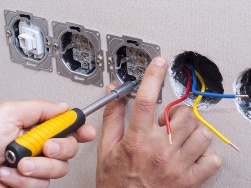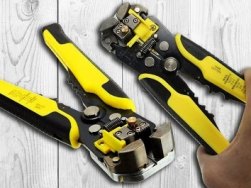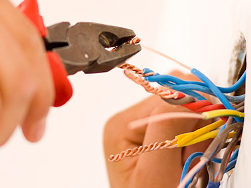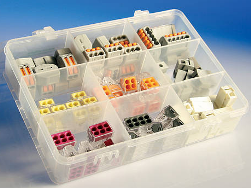The main mistakes when installing sockets and switches, how to prevent them
 Wanting to install a socket or switch during repair or just intending to replace an obsolete model with a more modern one, we usually decide to do it ourselves. As a rule, such a decision is connected with a very misconception about what and how to do, with absolute confidence, however, in their abilities and strengths.
Wanting to install a socket or switch during repair or just intending to replace an obsolete model with a more modern one, we usually decide to do it ourselves. As a rule, such a decision is connected with a very misconception about what and how to do, with absolute confidence, however, in their abilities and strengths.
In reality, having no experience installing sockets or switches, not a single newcomer is immune from error. Due to the lack of proper experience, he can simply ruin the device or even damage the wiring, without paying attention to some important nuances that professionals know about. Meanwhile, frenzied zeal in such situations can end tragically, from electric shock to fire. In order to somehow prepare a beginner and warn him against possible failures, let's look at some important aspects of installing switches and sockets ...
Stripper - a tool for stripping wires, which are and how to use
 In the work of an electrician, one of the most frequent operations during electrical installation is stripping and connecting wires. In such seemingly simple actions, there are a number of nuances. Yes, and it is not recommended to remove the insulation from the wires with a knife, because if you do not have developed skills, you will damage the conductive wires. And this will lead to problems in posting in the future. Read about stripping tools in this article.
In the work of an electrician, one of the most frequent operations during electrical installation is stripping and connecting wires. In such seemingly simple actions, there are a number of nuances. Yes, and it is not recommended to remove the insulation from the wires with a knife, because if you do not have developed skills, you will damage the conductive wires. And this will lead to problems in posting in the future. Read about stripping tools in this article.
Fans will answer that you can remove the insulation with a conventional knife. You can do it this way, but there is a small problem. When stripping insulation from a soft wire with multi-wire cores, especially with cross-sectional conductors up to 1.5 sq. mm many make a mistake - cut the veins. As a result, the contact area decreases and the cross section due to the fact that the number of veins decreases. When stripping insulation from wires with monolithic or single-wire cores, another problem arises - the cores are notched ...
Terminals, clamps and sleeves for connecting copper and aluminum wires
 For more than a year now, as in residential buildings, it is again allowed to use aluminum alloy wiring. At the same time, quite often copper cables are also available in one apartment - the situation is acceptable, but requires special attention, since there is a problem of the correct transition from copper to aluminum. Consider the best solutions.
For more than a year now, as in residential buildings, it is again allowed to use aluminum alloy wiring. At the same time, quite often copper cables are also available in one apartment - the situation is acceptable, but requires special attention, since there is a problem of the correct transition from copper to aluminum. Consider the best solutions.
According to the Electrical Installation Rules, direct contact of aluminum with copper is prohibited: it provokes strong oxidation at the junction, due to which the contact resistance increases, the wiring heats up and burns. It is necessary to take this into account when choosing the connection option - the terminals, clamps or sleeves must be adapted specifically for the transition from copper to aluminum. For example, construction and mounting terminals (SMK) are designed to connect from two to eight conductors with a cross section of up to 4 mm2 on the principle of copper-copper, copper-aluminum, aluminum-aluminum ...
How to connect wires and cables of different sections
 It happens that when you install electrical wiring, you have to connect wires of different sections. And there is, apparently, no problem, because there are many different ways to do this. Nevertheless, in each case, one of the options will be most successful. We can talk about mounting a junction box, while installing a wall outlet is a completely different matter, where good contact and possibly the smallest transition resistance at the fixation point are very important.
It happens that when you install electrical wiring, you have to connect wires of different sections. And there is, apparently, no problem, because there are many different ways to do this. Nevertheless, in each case, one of the options will be most successful. We can talk about mounting a junction box, while installing a wall outlet is a completely different matter, where good contact and possibly the smallest transition resistance at the fixation point are very important.
From ancient times to this day, ordinary twisting has not lost popularity. Using twisting, it is easy to connect wires of close sections, for example 1 sq. Mm and 1.5 sq. Mm.And if the sections are very different? Then a good twist will not work, because the cores will not be equally snug against each other. In order for the twist to turn out to be high-quality, the wires should evenly wrap around each other, it should not be such that a thin wire is simply wound over a thick one, because then the contact will be bad ...
What are the nozzles for the grinder and rotary hammer for electrical work
 No electrical work in the building is complete without wall chipping. To lay hidden wiring, first a stroba (groove) is made in the wall, then cables are laid into it, after which the stroba with wiring is sealed with a solution.
No electrical work in the building is complete without wall chipping. To lay hidden wiring, first a stroba (groove) is made in the wall, then cables are laid into it, after which the stroba with wiring is sealed with a solution.
Traditionally, in the process of strobing, a special power tool called a stroborez (groove cutter) is first used, then a perforator with a special nozzle in the form of a scapula is used to completely clean the furrow. Finally, the wiring is laid in the gate. In general, channels in concrete or brick walls are made not only for wiring and other cables, but also for water and sewer pipes, ventilation ducts and all that sort of thing. In addition to wall chipping, electrical work includes: drilling holes for socket boxes, for soldering boxes, drilling holes for plastic mounting dowels etc....
Wago terminals: types, characteristics, how to choose and how to use it correctly
 Wago terminals: types, characteristics, how to choose and how to use correctly There are many ways to create contact between two or more conductors: terminals, lugs, sleeves, soldering, welding, twisting ... The German company Wago first introduced the design of terminals with spring contact in 1951 year, and now she is known as a manufacturer of popular connectors for wires. Small terminals for junction or junction boxes have been available since 1973. These terminals have their advantages, disadvantages and features, which we will consider in the article.
Wago terminals: types, characteristics, how to choose and how to use correctly There are many ways to create contact between two or more conductors: terminals, lugs, sleeves, soldering, welding, twisting ... The German company Wago first introduced the design of terminals with spring contact in 1951 year, and now she is known as a manufacturer of popular connectors for wires. Small terminals for junction or junction boxes have been available since 1973. These terminals have their advantages, disadvantages and features, which we will consider in the article.
Due to the ease of use, this method of connection has gained popularity, it is very convenient to use it for temporary connection to electricity, for example, at a construction site, the lever clamps will become indispensable. In general, the spring terminal blocks from the manufacturer VAGO can be divided into disposable and reusable (with lever clamp). The main series of sections that are connected by such terminals ...
How to hang a chandelier on a stretch ceiling
 When repairing an apartment, each stage requires a thoughtful approach - you need to decide how to make it not only beautiful, but also practical. The ceilings are finished in a variety of ways, from simple whitewashing or painting, to false ceilings made of drywall or stretch ceilings made of film or fabric. But you need to install lamps and chandeliers on it. If with plasterboard structures everything is more or less clear - it is rigid and you can attach the device to metal profiles, then with stretch ceilings the situation is different. In this article we will tell you how to choose and hang a chandelier on a suspended ceiling.
When repairing an apartment, each stage requires a thoughtful approach - you need to decide how to make it not only beautiful, but also practical. The ceilings are finished in a variety of ways, from simple whitewashing or painting, to false ceilings made of drywall or stretch ceilings made of film or fabric. But you need to install lamps and chandeliers on it. If with plasterboard structures everything is more or less clear - it is rigid and you can attach the device to metal profiles, then with stretch ceilings the situation is different. In this article we will tell you how to choose and hang a chandelier on a suspended ceiling.
A stretch ceiling is a canvas stretched at a distance from the ceiling. The distance is chosen by the customer and usually it is not less than 5 centimeters from the rough (main), for example, concrete ceiling. There are two types of stretch fabrics: PVC film and fabric. Both materials must not be overheated ...
Errors in wiring in corrugation
 Modern electricians lay wiring in the corrugation on the street, indoors, on the surface and inside the walls. Despite all the advantages of this installation method, there are a number of features of its use. The fact is that there are three varieties of corrugations and each of them is intended for use for certain purposes. In this article we will look at typical errors when laying cables and wires in the corrugation.
Modern electricians lay wiring in the corrugation on the street, indoors, on the surface and inside the walls. Despite all the advantages of this installation method, there are a number of features of its use. The fact is that there are three varieties of corrugations and each of them is intended for use for certain purposes. In this article we will look at typical errors when laying cables and wires in the corrugation.
Types of corrugation Strange as it may sound, but the corrugation is chosen by color.There are three main materials for the production of corrugated pipes, in order to prevent mistakes in the future, remember: white or gray - polyvinyl chloride (PVC), black or orange - low pressure polyethylene (HDPE), blue - polypropylene (PPR). What is the difference between corrugations? PVC corrugations are used indoors, and they crack due to ultraviolet radiation. But this material does not support combustion. The mechanical strength is lower than that of analogues ...
